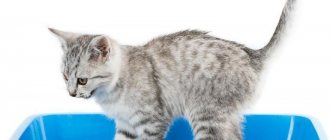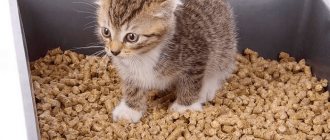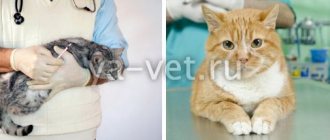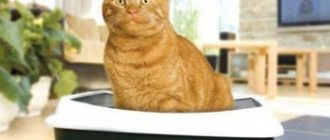( 1 votes, rating: 1.00 out of 5)
5589564
08/01/2021 owner reviews
It is very important that your newborn kitten starts pooping within a normal period of time, and the absence of poop is a cause for concern as it can be a symptom of even serious health problems. Read on to find out why this might happen and tips on how to help your kitten.
- Reasons why a kitten doesn't poop at all
- Reasons why a kitten does not poop when stimulated
- What to do
- How to treat constipation in kittens
- Conclusion
Possible reasons for lack of stool
The absence of stool in a kitten for 1-3 days should not cause panic in the owner if the animal’s behavior is otherwise normal.
But it’s worth palpating the abdomen and monitoring what and how the kitten eats.
Small kittens most often suffer from problems with bowel movements (constipation)
The main reasons for the absence of bowel movements in a small kitten:
- Changing the diet and replacing familiar food with a new one , especially if the kitten has just been weaned from the cat. A problem may also arise in a kitten that was picked up from the street: lack of food, consumption of various wastes and a sudden transition to homemade food can cause constipation.
- Unbalanced food with an abundance of meat and fish products or not enough water for the animal to drink. A small body is just beginning to get used to a new diet, so the introduction of new foods should be gradual.
- Worm infestation , most often in kittens picked up from the street. Due to the growth of a ball of worms, the kitten stops pooping.
- Adaptation and stress after moving to new owners can affect the lack of appetite and bowel movements.
- Hairballs that form due to licking can block the path in the intestines for the release of feces, so the kitten must be given a special paste that dissolves the hair.
- Diseases of the gastrointestinal tract, intestinal obstruction, chemostasis, coprostasis.
- Dry concentrated food.
- Large amount of food eaten.
- Foreign bodies entering the stomach, intestines - beads, paper, bones.
- Sedentary lifestyle.
If the kitten has not pooped for more than 3 days, the belly is swollen, and touching it causes pain in the baby, you should immediately consult a veterinarian.
Feces will begin to release toxic substances that will disrupt the functioning of the kidneys and liver, which can lead to death.
Be sure to read:
A cat often burps: causes, symptoms, what to do when vomiting after eating, prevention, what not to do
Prevention measures
Such an unpleasant phenomenon as constipation can be completely avoided. To do this, you need to adhere to the simplest rules of prevention:
- Give your kitten antiparasitic medications regularly to prevent the accumulation of helminths in the intestines.
- Teach your baby to an active lifestyle. An active, playful kitten suffers from constipation much less often than a phlegmatic little ball that constantly sleeps.
- If constipation is accompanied by vomiting, consult a doctor immediately!
- Brush the fur regularly to prevent it from collecting in the intestines.
- Adjust the menu. It must contain the required amount of fat, liquid, and fiber.
And lastly: do not neglect regular examinations by the veterinarian, because constipation may be caused by some quietly developing pathology in the baby’s body.
How to tell if a kitten is constipated
The animal becomes restless, runs around, looks for a place to go to the toilet, meows loudly when it sits in the tray for a long time. When palpating the abdomen, he tries to escape, since such movements cause pain for him.
When feeling the stomach, you can feel an oblong lump along the body, mainly on the right side, or a foreign object.
In a kitten, prolonged absence of stool can cause vomiting, lethargy, fever, and intermittent breathing.
How to help a kitten go to the toilet?
After finding out the reasons why the kitten does not poop or cannot do so, several manipulations are carried out that will help empty the intestines.
In a kitten, prolonged absence of stool can cause vomiting, lethargy, fever, and intermittent breathing.
First of all, to alleviate the animal’s condition, a light massage of the abdomen is performed in a lying position clockwise, while in a standing position, the sides are stroked towards the tail.
Give low-fat kefir or flaxseed oil. If such a procedure does not bring relief to the animal within 3-5 hours, then you should use folk remedies or medications.
Important! Before taking any medication, you should consult your veterinarian.
Vaseline oil
For better removal of feces, Vaseline oil is used: it is absorbed into the intestines for a long time and promotes the removal of feces from the intestines.
Vegetable and castor oils are quickly absorbed; the likelihood that they will help remove feces is very low. Rather, they will aggravate the situation, putting double stress on the liver.
Vaseline oil is added to food or given after meals 3 times a day. 1.5 ml is injected into the oral cavity with a syringe without a needle for kittens from 1 to 3 months. For older adults, the dose can be increased to 2-2.5 ml.
Bar of soap
A method that will cause strong resistance in the animal, so you need to securely secure the kitten and prepare for the procedure.
They take baby soap, break off a piece of it and shape it into a small candle.
Be sure to read:
Black feces in a cat: normal or pathological, when is it a dangerous symptom, diagnosis, how to treat
The piece should be similar to the tip of a pen rod, 2-3 mm thicker. Carefully wrap the animal in a towel, lay it on its left side, and lubricate the anus with Vaseline oil or baby cream.
Wet the soap and slowly insert it into the kitten's anus , hold the passage for 1-2 minutes so that the soap does not jump out. After the procedure, release the animal and pet it to relieve stress. The result should appear in 2-4 hours.
Attention! Before carrying out the procedure, you must consult a doctor! If soap is administered incorrectly, there is a risk of injuring your pet!
Radical measures
Radical measures include an enema and taking medications.
It is better to carry them out after consultation with a veterinarian and with full confidence that the result of constipation is poor nutrition, otherwise serious consequences may occur.
It is better to carry out an enema together, so that one person fixes the kitten, and the second carries out the procedure. It is performed in the bathroom next to the tray.
Take unnecessary fabric, soft toilet paper. You will need a syringe with a rubber tip (the smallest one) with 50 ml of boiled warm water.
Radical measures include an enema
The tip and anus of the kitten are lubricated with baby cream. Then slowly insert the tip 1 cm into the passage and also carefully and slowly introduce water.
Immediately after removing the syringe, you need to fix the anus for 1-1.5 minutes, then release it. The kitten should go to the toilet loosely.
Medicines to help relieve constipation:
- Duphalac;
- Lizalak;
- sodium picosulfate;
- Lactusan.
The duration of the course of treatment is 3-5 days according to the recommendation of a specialist. The dosage is calculated individually per kg of animal weight.
Regular feeding
While the kittens were lying in the above-mentioned basin, I found on the Internet that it is necessary to feed the orphans with a special cat's milk substitute, sold in veterinary pharmacies. But 10% cream and regular high-fat milk are also suitable; sometimes you need to add 0.5 liters of raw yolk and 4 teaspoons of granulated sugar. I immediately went to the store.
I used glass pharmacy vials from penicillin as bottles, and the rubber parts of ordinary pharmacy pipettes became the nipples. They calmly stretch onto the wide neck of the bubbles. But you need to immediately purchase about 20 pipettes. They are sometimes torn, sometimes lost, sometimes spoiled by the kittens’ rapidly growing teeth.
The milk needs to be heated, you can do it for 3-5 seconds in the microwave, check before feeding to see if it is too hot - in general, everything is the same as with human children. And, of course, you need to wash and dry the nipple pipettes and bubbles after each feeding. It is convenient to pour the daily portion of milk into a separate jar with a plastic lid, store the jar in the refrigerator, stick a 10 ml syringe with a needle into the lid, and use it to pour milk into the bottle through a hole in the nipple.
The volume of a kitten's serving increases from 10-20 ml of milk in the first week to 100 ml by 3-4 weeks; they set the frequency of feedings for themselves. By two weeks, the 10 ml penicillin bottle can be replaced with a larger volume bottle, for example, a 20 ml pharmaceutical bottle of bacteriophage, and by three weeks - a 100 ml bottle of alcohol, if the number of kittens is more than one.
Kittens eat depending on the weather - sometimes every hour, sometimes every 3-4 hours in sleepy, cloudy weather. When they are full, they lean away from the nipple. At night, our kittens slept decently, giving me a rest from midnight until exactly 8-10 in the morning. Only on the first night they made me stay awake, eating every hour.
We invite you to familiarize yourself with: Organization of herd reproduction (beef cattle)
It is convenient to feed kittens in your arms, with their back facing you, holding them with one hand under their front legs and belly, and holding the bottle with the other. A hungry kitten will fiercely cling to the bottle, preventing itself from sucking on the nipple, so at the beginning of feeding you need to hold your paws, and then when the kitten is calmly sucking, let go, then he will wrap his paws around the bottle.
Visually or on scales, monitor the growth of the babies, by a week the weight should double and reach about 250 g, at 2 weeks - about 400 g, per month about 600-700 g, at 2 months - about 1300 g, by 6-8 months it reaches the size of an adult cat . If the kitten is not gaining weight, is lethargic and weak, go to the vet immediately!
One and a half month old cats in the same box as in the previous picture. They learned to jump over the partition, so it was removed.
Eight month old cat in a box with a bottom the same size as a cardboard box.
At the age of 15-20 days, you can feed kittens with soaked dry food for kittens, a couple of crackers are enough, or natural food. We started with natural complementary foods, in mini quantities - rice, corn, buckwheat porridge, cottage cheese with sour cream, boiled chicken or beef. Our kittens refused to eat boiled vegetables.
When the kittens were constipated for longer than 3 days, I gave them a little Vaseline oil (from a syringe into the mouth), and did mini-enemas with warm soapy water (a syringe lubricated with Vaseline oil). Around the age of one and a half months, we switched to dry food and canned food for kittens, since the kittens refused to eat natural food.
What to feed a cat with constipation
If constipation occurs, you need to reconsider the animal's diet. Food should be light with plenty of water or low-fat broth based on chicken meat (skinless fillet) or vegetables (various types of cabbage).
Be sure to read:
Vomiting in a cat: causes, what different types of vomit indicate, first aid, treatment, when it is not dangerous
The kitten's diet includes:
- fermented milk products (kefir, yogurt);
- boiled vegetables (pumpkin, carrots, beets, zucchini)
- fiber-rich cereals (oatmeal, pearl barley, millet).
The main thing is that the diet needs to be balanced with the gradual introduction of different foods for the kitten.
Do not neglect preventive measures or feed only dry food.
Saucer training, education
The most difficult thing for us was to teach the kittens to lap up milk on their own and eat solid food from a saucer. They loved the bottle. We put small peas of complementary food into their mouths. Why should they give up such pleasure?
In general, kittens, obeying the feeling of hunger, begin to lap at 3-3.5 weeks from the saucer. But with us, they cried shrilly, poked at the saucer, sneezed from milk that got into their noses and could not understand what to do. There was no one to show how to lap; there were no adult cats or dogs nearby. A week of unsuccessful attempts passed, but then guests came to us - experienced cat breeders and in half an hour they taught the kittens to lap from a saucer.
We just learned to eat from a saucer.
If at 2-3 weeks the kittens are not yet playing, if you take them out of the nest - they can barely walk, waddling from side to side, and constantly squeak, then by 4 weeks they are already accomplished tomboys who have learned to climb onto the sofa, jump on a stool, bite and fight.
Forty-day-old kittens.
Do not allow the kitten to do things that you will not allow him to do as an adult - climb curtains, on the table, sharpen his claws on furniture, scratch his owner. You can teach him a nickname from any age, just call the kitten by his nickname, and he will quickly begin to respond at her. Kittens can rumble and purr from the first days, but they will consciously thank their owners for dinner by about three weeks. Talk to the kitten, and he will answer you with purrs, purrs and affection.











